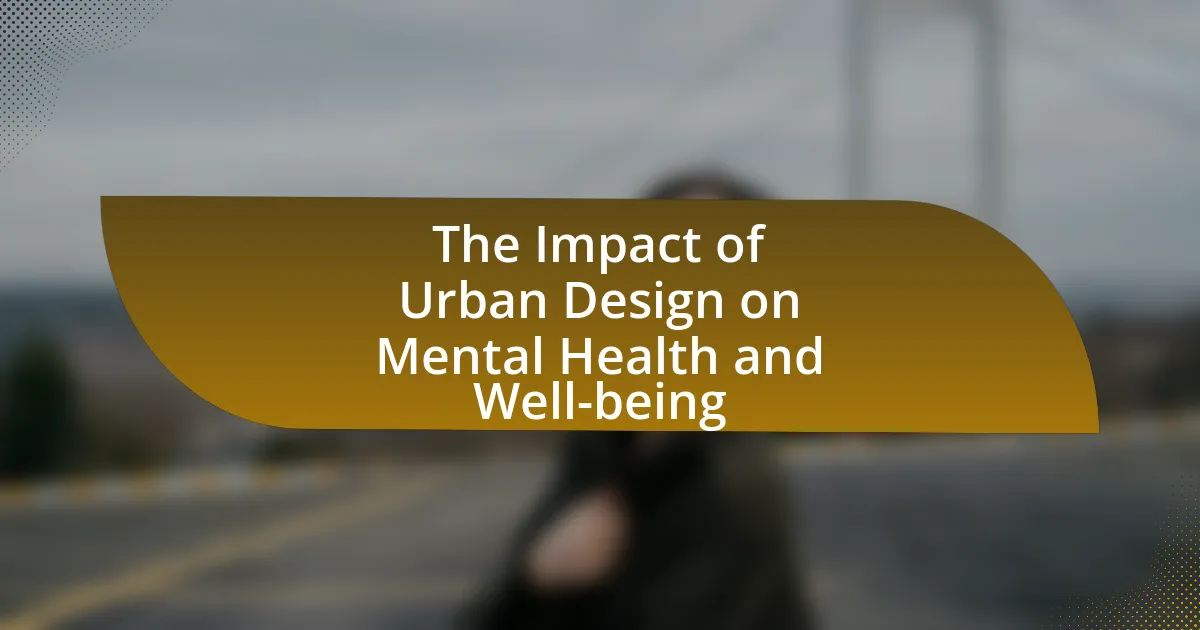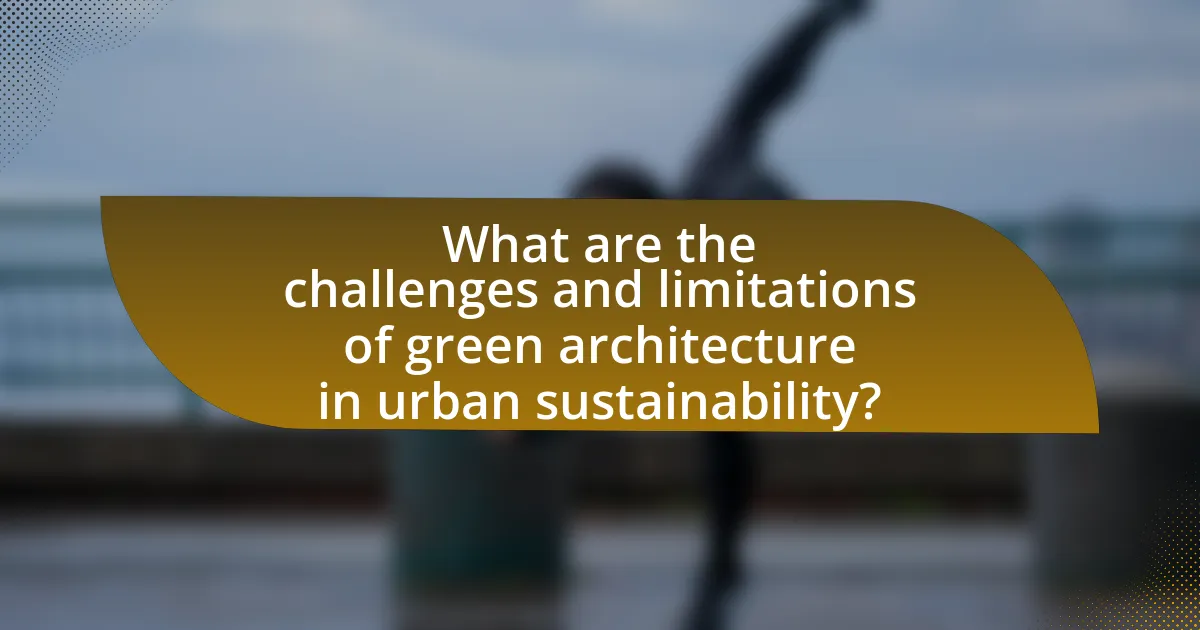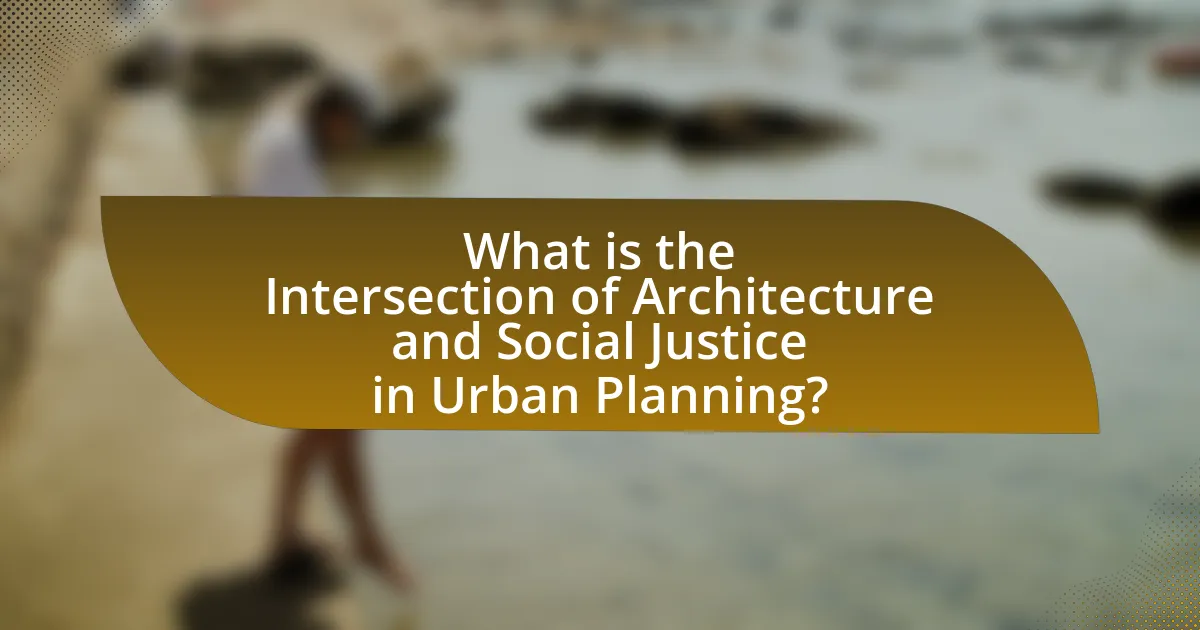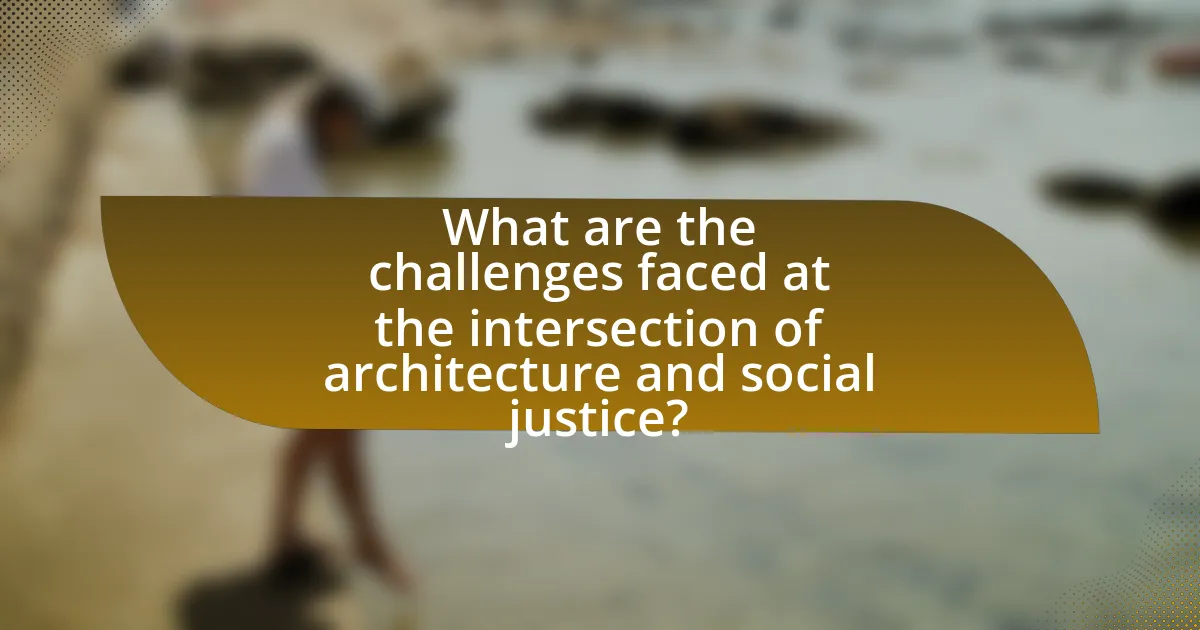Urban resilience refers to the capacity of urban areas to anticipate, prepare for, respond to, and recover from climate-related hazards and stresses. This article explores the significance of urban resilience in the context of climate change, highlighting key principles such as adaptability, diversity, integration, and sustainability. It examines the role of architecture in enhancing urban resilience through innovative design strategies, including green infrastructure and sustainable materials. Additionally, the article addresses the challenges cities face in achieving resilience, the influence of socio-economic factors, and the importance of community engagement and stakeholder collaboration in promoting effective resilience initiatives.

What is Urban Resilience in the Context of Climate Change?
Urban resilience in the context of climate change refers to the ability of urban areas to anticipate, prepare for, respond to, and recover from climate-related hazards and stresses. This concept emphasizes the integration of adaptive strategies in urban planning and infrastructure to mitigate the impacts of climate change, such as flooding, heatwaves, and sea-level rise. For instance, cities like New York have implemented green infrastructure, such as permeable pavements and green roofs, to manage stormwater and reduce urban heat. Studies show that enhancing urban resilience can significantly lower economic losses and improve community well-being during climate events, as evidenced by the 2013 New York City Recovery and Resiliency Plan, which allocated $20 billion for climate adaptation measures.
How is Urban Resilience Defined?
Urban resilience is defined as the capacity of urban systems to absorb, recover from, and adapt to various stresses and shocks, including climate change impacts. This definition encompasses the ability of cities to maintain functionality and improve their infrastructure, social systems, and environmental health in the face of challenges such as extreme weather events, economic fluctuations, and social disruptions. Research indicates that urban resilience is critical for sustainable development, as cities are increasingly vulnerable to climate-related risks, with the United Nations reporting that over 50% of the global population now resides in urban areas, heightening the need for effective resilience strategies.
What are the key principles of Urban Resilience?
The key principles of Urban Resilience include adaptability, diversity, integration, and sustainability. Adaptability refers to the ability of urban systems to adjust to changing conditions and recover from disturbances, ensuring functionality during crises. Diversity enhances resilience by incorporating a variety of elements, such as mixed land uses and diverse ecosystems, which can buffer against shocks. Integration emphasizes the interconnectedness of social, economic, and environmental systems, promoting collaborative approaches to urban planning and disaster response. Sustainability focuses on long-term viability, ensuring that urban development meets present needs without compromising future generations. These principles are supported by frameworks like the United Nations’ Sendai Framework for Disaster Risk Reduction, which highlights the importance of resilience in urban planning.
Why is Urban Resilience important for cities?
Urban resilience is crucial for cities because it enhances their ability to withstand and recover from various shocks and stresses, including climate change impacts, natural disasters, and socio-economic challenges. Cities that prioritize urban resilience can reduce vulnerability, protect infrastructure, and ensure the continuity of essential services during crises. For instance, research by the United Nations indicates that resilient cities can save up to 50% in recovery costs after disasters by implementing proactive measures. This proactive approach not only safeguards lives but also promotes sustainable development and economic stability in urban areas.
What Role Does Architecture Play in Urban Resilience?
Architecture plays a critical role in urban resilience by designing buildings and spaces that can withstand and adapt to climate change impacts. Resilient architecture incorporates sustainable materials, energy-efficient systems, and adaptive designs that respond to environmental challenges such as flooding, heatwaves, and storms. For instance, the integration of green roofs and permeable surfaces can mitigate urban heat and manage stormwater effectively, as evidenced by studies showing that green infrastructure can reduce runoff by up to 65%. Additionally, resilient architectural practices prioritize community engagement and social equity, ensuring that vulnerable populations are protected and included in urban planning processes. This multifaceted approach not only enhances the physical durability of urban environments but also fosters social cohesion and economic stability in the face of climate-related disruptions.
How can architectural design enhance Urban Resilience?
Architectural design can enhance urban resilience by integrating adaptive strategies that address climate change impacts. For instance, incorporating green roofs and permeable surfaces can manage stormwater effectively, reducing flooding risks. Research shows that cities with green infrastructure experience up to 30% less runoff during heavy rainfall events, demonstrating the effectiveness of these design elements. Additionally, designing buildings to withstand extreme weather conditions, such as hurricanes or heatwaves, can significantly reduce damage and recovery costs. The National Institute of Building Sciences reports that resilient building practices can save communities up to $4 for every $1 invested in mitigation measures. Thus, architectural design plays a crucial role in fostering urban resilience through sustainable and adaptive solutions.
What are examples of resilient architectural features?
Examples of resilient architectural features include elevated structures, green roofs, and stormwater management systems. Elevated structures, such as homes built on pilings, protect against flooding by raising living spaces above potential water levels. Green roofs provide insulation and reduce urban heat, while also managing rainwater runoff, thereby mitigating flooding risks. Stormwater management systems, including permeable pavements and bioswales, enhance water absorption and reduce surface runoff, contributing to flood resilience. These features are essential in urban environments facing climate change impacts, as they help maintain functionality and safety during extreme weather events.
What Challenges Do Cities Face in Achieving Urban Resilience?
Cities face significant challenges in achieving urban resilience, primarily due to inadequate infrastructure, limited financial resources, and social inequality. Inadequate infrastructure hampers cities’ ability to withstand climate-related events, as many urban areas lack the necessary systems to manage flooding, heatwaves, and other climate impacts effectively. Limited financial resources restrict investment in resilient technologies and adaptive strategies, making it difficult for cities to implement necessary upgrades. Furthermore, social inequality exacerbates vulnerability, as marginalized communities often lack access to resources and support systems that enhance resilience. According to the United Nations, over 1 billion people live in slums, which are particularly susceptible to climate risks, highlighting the urgent need for equitable urban planning and investment in resilience initiatives.
What are the main environmental challenges impacting urban areas?
The main environmental challenges impacting urban areas include air pollution, water scarcity, waste management, and climate change. Air pollution, primarily from transportation and industrial activities, poses significant health risks, contributing to respiratory diseases and premature deaths; for instance, the World Health Organization estimates that air pollution causes about 7 million deaths annually. Water scarcity affects urban areas due to over-extraction of groundwater and pollution of water sources, leading to inadequate access to clean water for millions. Waste management challenges arise from increasing urban populations generating more waste than cities can handle, resulting in overflowing landfills and environmental degradation. Lastly, climate change exacerbates urban vulnerabilities through extreme weather events, rising sea levels, and heatwaves, with cities like New Orleans and Miami facing heightened risks of flooding and infrastructure damage.
How do socio-economic factors influence Urban Resilience?
Socio-economic factors significantly influence urban resilience by determining the capacity of communities to prepare for, respond to, and recover from adverse events. Wealthier communities typically have better access to resources, infrastructure, and services, which enhances their ability to withstand and recover from disasters. For instance, a study by the National Institute of Building Sciences found that every dollar invested in disaster mitigation can save society an average of six dollars in future disaster costs, highlighting the importance of economic investment in resilience. Additionally, social cohesion and community engagement, often found in socio-economically stable areas, contribute to effective disaster response and recovery efforts. Conversely, marginalized communities with limited economic resources face greater vulnerabilities, making them less resilient to climate change impacts.
How Can Urban Resilience Be Measured?
Urban resilience can be measured through a combination of quantitative and qualitative indicators that assess a city’s ability to anticipate, prepare for, respond to, and recover from adverse events. These indicators often include metrics such as infrastructure robustness, community engagement levels, economic diversity, and environmental sustainability. For instance, the City Resilience Index developed by Arup and the Rockefeller Foundation evaluates urban resilience across multiple dimensions, providing a structured framework for cities to assess their resilience capabilities. This index incorporates data on social, economic, and environmental factors, demonstrating that a comprehensive approach to measurement can yield actionable insights for improving urban resilience.
What metrics are used to assess Urban Resilience?
Metrics used to assess Urban Resilience include social, economic, and environmental indicators. Social indicators may encompass community engagement levels, access to resources, and social equity, while economic metrics often involve local economic diversity, employment rates, and infrastructure investment. Environmental indicators typically assess ecosystem health, green space availability, and vulnerability to climate-related hazards. These metrics are validated through frameworks like the City Resilience Index, which evaluates urban areas based on their ability to withstand and recover from shocks and stresses, demonstrating the importance of a multifaceted approach to resilience assessment.
How do these metrics inform architectural strategies?
Metrics inform architectural strategies by providing quantifiable data that guides decision-making in the design and implementation of resilient structures. For instance, metrics such as energy efficiency ratings, carbon footprint assessments, and climate vulnerability indices enable architects to evaluate the sustainability and adaptability of their designs in the face of climate change. These metrics help identify areas where improvements can be made, ensuring that buildings not only meet current environmental standards but also anticipate future climate challenges. By analyzing historical data on weather patterns and urban heat islands, architects can create designs that mitigate risks associated with extreme weather events, thereby enhancing urban resilience.

What Architectural Strategies Are Effective for Climate Change Adaptation?
Effective architectural strategies for climate change adaptation include the implementation of green roofs, passive solar design, and the use of resilient materials. Green roofs help manage stormwater, reduce urban heat, and improve air quality, as evidenced by studies showing a reduction in surface temperatures by up to 10 degrees Fahrenheit in urban areas. Passive solar design optimizes natural light and heat, reducing energy consumption by up to 30%, according to the U.S. Department of Energy. Additionally, resilient materials, such as flood-resistant concrete and heat-reflective coatings, enhance building durability against extreme weather events, with research indicating that buildings using these materials can withstand flooding and high winds more effectively.
What are the key architectural strategies for enhancing Urban Resilience?
Key architectural strategies for enhancing urban resilience include the integration of green infrastructure, adaptive building designs, and community engagement in planning processes. Green infrastructure, such as green roofs and permeable pavements, helps manage stormwater and reduce urban heat, thereby mitigating flooding and heat island effects. Adaptive building designs, which incorporate flexible layouts and materials that can withstand extreme weather, ensure structures remain functional during climate events. Community engagement fosters local knowledge and investment in resilience initiatives, leading to more effective and culturally relevant solutions. These strategies collectively contribute to a more resilient urban environment capable of withstanding climate change impacts.
How does green architecture contribute to climate change adaptation?
Green architecture contributes to climate change adaptation by incorporating sustainable design principles that enhance resilience to environmental changes. This architectural approach utilizes materials and technologies that reduce energy consumption, manage water efficiently, and promote biodiversity, thereby mitigating the impacts of climate change. For instance, green roofs and walls can lower urban temperatures, reduce stormwater runoff, and improve air quality, which are critical in adapting to increased heat and extreme weather events. Studies indicate that buildings designed with green architecture can reduce energy use by up to 50%, significantly lowering greenhouse gas emissions and fostering a more sustainable urban environment.
What role do sustainable materials play in resilient design?
Sustainable materials are essential in resilient design as they enhance the durability and adaptability of structures in the face of climate change. These materials, such as bamboo, recycled steel, and reclaimed wood, not only reduce environmental impact but also improve the longevity of buildings by resisting weathering and degradation. For instance, using recycled materials can lower carbon emissions by up to 70% compared to traditional materials, thereby contributing to a more sustainable built environment. Additionally, sustainable materials often require less energy for production and maintenance, which further supports resilience by minimizing resource depletion and promoting energy efficiency.
How Can Urban Planning Integrate Architectural Strategies?
Urban planning can integrate architectural strategies by fostering collaboration between urban planners and architects to create resilient, sustainable environments. This integration involves aligning zoning regulations with architectural design principles, ensuring that buildings are not only functional but also adaptable to climate change impacts. For instance, incorporating green roofs and permeable surfaces in urban designs can mitigate flooding and reduce heat islands, as evidenced by studies showing that green infrastructure can lower urban temperatures by up to 5 degrees Celsius. Additionally, mixed-use developments can enhance community resilience by promoting walkability and reducing reliance on vehicles, which is supported by research indicating that such designs can decrease carbon emissions significantly.
What are the benefits of integrating architecture with urban planning?
Integrating architecture with urban planning enhances sustainability, improves community resilience, and fosters economic growth. This integration allows for the design of buildings that are not only aesthetically pleasing but also environmentally efficient, reducing energy consumption and minimizing waste. For instance, the incorporation of green roofs and energy-efficient materials in urban designs can significantly lower urban heat islands, contributing to climate change adaptation. Furthermore, well-planned urban spaces promote social interaction and accessibility, which can lead to stronger community ties and increased local economies. Studies have shown that cities that prioritize integrated planning experience higher rates of investment and improved quality of life for residents.
How can zoning laws support resilient architectural practices?
Zoning laws can support resilient architectural practices by establishing regulations that promote sustainable land use, density, and building design. These laws can mandate green infrastructure, such as permeable surfaces and green roofs, which enhance stormwater management and reduce urban heat islands. For instance, cities like Portland have implemented zoning regulations that encourage the use of eco-friendly materials and energy-efficient designs, leading to reduced carbon footprints. Additionally, zoning can facilitate mixed-use developments that enhance community resilience by providing essential services within walkable distances, thereby reducing reliance on automobiles. This approach not only fosters social cohesion but also minimizes environmental impacts, aligning with the goals of urban resilience in the face of climate change.
What Innovations Are Shaping the Future of Resilient Architecture?
Innovations shaping the future of resilient architecture include advanced materials, smart technologies, and sustainable design practices. Advanced materials such as self-healing concrete and energy-efficient insulation enhance durability and reduce energy consumption, addressing climate challenges. Smart technologies, including IoT sensors and building management systems, enable real-time monitoring and adaptive responses to environmental changes, improving building performance. Sustainable design practices, such as green roofs and rainwater harvesting systems, promote ecological balance and resource efficiency. These innovations collectively contribute to creating structures that withstand climate impacts while minimizing their environmental footprint.
How is technology influencing architectural strategies for resilience?
Technology is significantly influencing architectural strategies for resilience by enabling the integration of advanced materials, data analytics, and smart systems into building design. For instance, the use of resilient materials such as self-healing concrete and energy-efficient insulation enhances structural durability against climate impacts. Additionally, data analytics allows architects to assess environmental risks and optimize designs accordingly, as seen in projects that utilize geographic information systems (GIS) to analyze flood zones. Smart systems, including IoT sensors, facilitate real-time monitoring of building performance and environmental conditions, allowing for adaptive responses to changing climate scenarios. These technological advancements collectively contribute to more sustainable and resilient urban environments, as evidenced by the increasing adoption of green building certifications like LEED, which emphasize resilience in design.
What are some case studies of innovative resilient architecture?
Some case studies of innovative resilient architecture include the Bosco Verticale in Milan, Italy, and the Floating Seahorse Villas in Dubai, UAE. The Bosco Verticale, designed by Stefano Boeri, features vertical forests that improve air quality and provide insulation, showcasing how urban buildings can integrate nature to enhance resilience against climate change. The Floating Seahorse Villas utilize buoyant design principles to adapt to rising sea levels, demonstrating innovative approaches to living in harmony with aquatic environments. Both projects exemplify how architecture can respond to environmental challenges while promoting sustainability and resilience.

What Best Practices Should Be Followed for Urban Resilience?
Best practices for urban resilience include integrating green infrastructure, enhancing community engagement, and implementing adaptive land-use planning. Green infrastructure, such as parks and green roofs, mitigates flooding and improves air quality, as evidenced by studies showing a 30% reduction in stormwater runoff in cities that adopt these practices. Community engagement fosters local ownership and ensures that resilience strategies reflect the needs of residents, which has been shown to increase the effectiveness of disaster response. Adaptive land-use planning involves zoning regulations that account for climate risks, leading to more sustainable urban development. These practices collectively contribute to a city’s ability to withstand and recover from climate-related challenges.
What are the essential best practices for architects in promoting Urban Resilience?
Architects can promote urban resilience by integrating sustainable design principles, utilizing adaptive reuse of existing structures, and implementing green infrastructure. Sustainable design principles, such as energy efficiency and the use of renewable materials, reduce environmental impact and enhance building longevity. Adaptive reuse allows for the transformation of old buildings into functional spaces, minimizing waste and preserving cultural heritage. Green infrastructure, including permeable pavements and urban forests, mitigates flooding and improves air quality. These practices are supported by studies indicating that cities employing such strategies experience greater resilience to climate-related challenges, as evidenced by the Urban Land Institute’s report on resilient urban design.
How can architects collaborate with communities for effective resilience strategies?
Architects can collaborate with communities for effective resilience strategies by engaging in participatory design processes that incorporate local knowledge and needs. This collaboration ensures that resilience strategies are contextually relevant and culturally appropriate, enhancing community buy-in and effectiveness. For instance, the American Institute of Architects emphasizes the importance of community engagement in the design process, stating that involving residents leads to solutions that are more sustainable and reflective of the community’s values. Additionally, case studies, such as the Rebuild by Design initiative, demonstrate how architects can work alongside communities to develop innovative solutions that address specific vulnerabilities, ultimately fostering a sense of ownership and empowerment among residents.
What role does education play in fostering resilient architectural practices?
Education plays a crucial role in fostering resilient architectural practices by equipping future architects with the knowledge and skills necessary to design buildings that can withstand climate change impacts. Through curricula that emphasize sustainability, adaptive reuse, and innovative materials, educational institutions prepare students to address environmental challenges effectively. For instance, programs that incorporate hands-on projects and interdisciplinary approaches enable students to understand the complexities of urban resilience. Research indicates that architects trained in resilience-focused education are more likely to implement strategies that enhance the durability and adaptability of structures, thereby contributing to long-term sustainability in urban environments.
How Can Stakeholders Support Urban Resilience Initiatives?
Stakeholders can support urban resilience initiatives by actively participating in planning, funding, and implementing strategies that enhance community adaptability to climate change. For instance, local governments can create policies that incentivize sustainable building practices, while private sector partners can invest in green infrastructure projects. Research indicates that collaborative efforts, such as the “Resilient Cities” initiative by the United Nations, demonstrate that multi-stakeholder engagement leads to more effective resilience outcomes, as evidenced by cities that have successfully reduced vulnerability through shared resources and knowledge.
What actions can local governments take to promote resilient architecture?
Local governments can promote resilient architecture by implementing building codes that require sustainable materials and designs. These codes can mandate features such as elevated structures in flood-prone areas, energy-efficient systems, and the use of renewable resources. For instance, cities like New Orleans have adopted strict building regulations post-Hurricane Katrina to enhance resilience against future storms. Additionally, local governments can provide incentives, such as tax breaks or grants, for developers who incorporate resilient design principles, thereby encouraging investment in sustainable infrastructure. Furthermore, engaging in community planning that prioritizes green spaces and natural barriers can mitigate climate impacts, as seen in cities like Copenhagen, which integrates water management into urban design.
How can private sector involvement enhance Urban Resilience efforts?
Private sector involvement can enhance Urban Resilience efforts by providing innovative solutions, funding, and expertise in technology and infrastructure development. For instance, companies specializing in green building materials can contribute to sustainable construction practices, which are essential for adapting to climate change. Additionally, private investments in urban infrastructure can lead to the development of resilient systems, such as flood defenses and energy-efficient buildings, which are crucial for mitigating climate impacts. According to a report by the Global Facility for Disaster Reduction and Recovery, private sector engagement can mobilize up to $1 trillion annually for climate adaptation projects, demonstrating the significant financial and technical resources that the private sector can bring to urban resilience initiatives.
What Practical Steps Can Individuals Take to Contribute to Urban Resilience?
Individuals can contribute to urban resilience by adopting sustainable practices in their daily lives. This includes reducing energy consumption through energy-efficient appliances, which can lower greenhouse gas emissions and decrease reliance on fossil fuels. Additionally, individuals can engage in community gardening or tree planting initiatives, which enhance green spaces and improve urban biodiversity. Participating in local disaster preparedness programs also strengthens community resilience by ensuring that individuals are equipped to respond effectively to emergencies. Furthermore, advocating for policies that promote sustainable urban development can influence local governance and resource allocation, fostering a more resilient urban environment. These actions collectively support the adaptation of cities to climate change impacts, as evidenced by studies showing that community engagement and green infrastructure significantly enhance urban resilience.
How can residents advocate for resilient architectural practices in their communities?
Residents can advocate for resilient architectural practices in their communities by organizing local forums to discuss climate challenges and potential architectural solutions. Engaging with local government officials and planning departments allows residents to influence policy decisions that prioritize sustainable building practices. Additionally, residents can collaborate with architects and urban planners to promote designs that incorporate green infrastructure, such as rain gardens and permeable pavements, which enhance resilience against flooding. Evidence from the American Institute of Architects shows that community engagement in planning processes leads to more effective and accepted architectural solutions, thereby reinforcing the importance of resident advocacy in shaping resilient urban environments.
What resources are available for individuals interested in Urban Resilience?
Individuals interested in Urban Resilience can access a variety of resources, including academic journals, online courses, and community organizations focused on sustainability and climate adaptation. For instance, the journal “Urban Climate” publishes research on urban resilience strategies, while platforms like Coursera and edX offer courses on climate change and urban planning. Additionally, organizations such as the Urban Land Institute provide guidelines and case studies on resilient urban development. These resources collectively support knowledge acquisition and practical application in the field of Urban Resilience.










































